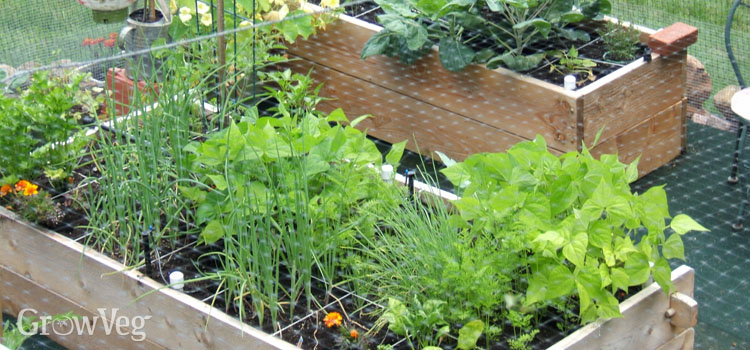Square Foot Gardening Plans For Rolling Boxes
Planning a Square Foot Vegetable Garden

Square Foot Gardening (commonly referred to as SFG) is a planting method that was developed by American author and TV presenter Mel Bartholomew in the 1970s. It's a simple way to create easy-to-manage gardens with raised beds that need a minimum of time spent maintaining them. SFG rapidly gained popularity during the 1980s through Mel's first book and television series and since then has spread across the world, eventually going 'mainstream' with several companies offering ready-to-assemble SFG gardens. SFG advocates claim it produces more, uses less soil and water and takes just 2% of the time spent on a traditional garden. So what makes Square Foot Gardening special and why don't all gardeners use it?
SFG was developed as a reaction to the inefficiencies of traditional gardening. In 1975 Mel Bartholomew had just retired as an engineer and decided to take up gardening as a hobby. It was only natural that he would apply his analytical skills to the problems he encountered. In particular he found the average gardener was spending hours weeding the big gaps between long rows of plants, creating unnecessary work for themselves. It soon became clear that getting rid of rows and using intensive deep-beds could dramatically cut the amount of maintenance the garden required. Add a one-foot square grid on top and it became easy to space and rotate crops.
The Square Foot Gardening System
Over the years the SFG system has evolved into a precise set of rules:
There's a purpose to each of these 'rules' and together they make up a powerful and almost fail-safe method for successful gardening. It's a great method for new gardeners, people who have little time, the elderly or disabled (SFG gardens can be built at a raised height to make them more accessible) and children. Many schools have embraced the SFG method because it's easy to install and maintain without becoming an additional burden for the teacher. However, there are some limitations:
- Easy to Outgrow: Although many vegetables can be grown in SFG gardens it struggles to accommodate larger plants (squash, melons, main-crop potatoes etc), perennials (globe artichokes, rhubarb) and fruit bushes/trees. Once new gardeners experience the success of SFG gardens they often want to expand the range of crops they grow beyond the standard SFG crops.
- Non-renewable Resources: There's no doubt that 'Mel's Mix' makes an excellent soil for vegetables . However, two of the three ingredients come from non-renewable sources. Peat takes thousands of years to develop and is a valuable natural sink for greenhouse gases. Vermiculite is mined and is therefore also a non-renewable resource with a significant carbon footprint. In common with many gardeners I won't use peat and would prefer not to use vermiculite.
- Expensive for Large Gardens: Although SFG beds are cheap to maintain they are quite expensive to set up if you have a large area and want to fill it quickly.
None of these reasons prevent SFG from being a useful part of a garden though – you can use 100% recycled compost in the beds instead of Mel's Mix, gradually build up the number of SFG beds and combine it with areas of your garden which are set aside for fruit trees and larger crops. Many of the SFG techniques that were revolutionary in the 1980s are now commonly used for vegetable gardening – deep raised beds, not compacting soil, removable covers and plant supports etc.

Planning a Square Foot Garden
At GrowVeg we regularly get enquiries from gardeners following the SFG method who want to plan their beds using our Garden Planner. So we introduced Square Foot Gardening mode in the Garden Planner that makes it easy to add one-foot squares of plants as well as using all the other powerful features of the software such as crop rotation, tracking varieties etc. Best of all is that the SFG plants can be part of a larger garden plan that includes more traditional planting layouts and large plants, so there's the flexibility to combine different methods in a plan of a single garden area.
Square Foot Gardening was revolutionary when it was first invented and it's still a great system for people who are starting out, have limited space or want a highly organized method to follow. However, you don't need to follow SFG to benefit from gardening with raised beds and good organization. There's a great quote: "If the only tool you have is a hammer, you tend to see every problem as a nail." SFG works really well for many situations but it doesn't fit everything. Despite my reservations I still recommend it as being the right option for many and the book is really easy to follow. The success it brings can often lead people on to discovering the delights of fruit trees, using barrels to grow huge crops of potatoes or managing a greenhouse full of high-value crops. It's a great stepping-stone to the world of growing your own food and that's why 35 years on it's still going strong.
< All Guides
Square Foot Gardening Plans For Rolling Boxes
Source: https://www.growveg.com/guides/planning-a-square-foot-vegetable-garden/
Posted by: martinhambsood.blogspot.com

0 Response to "Square Foot Gardening Plans For Rolling Boxes"
Post a Comment